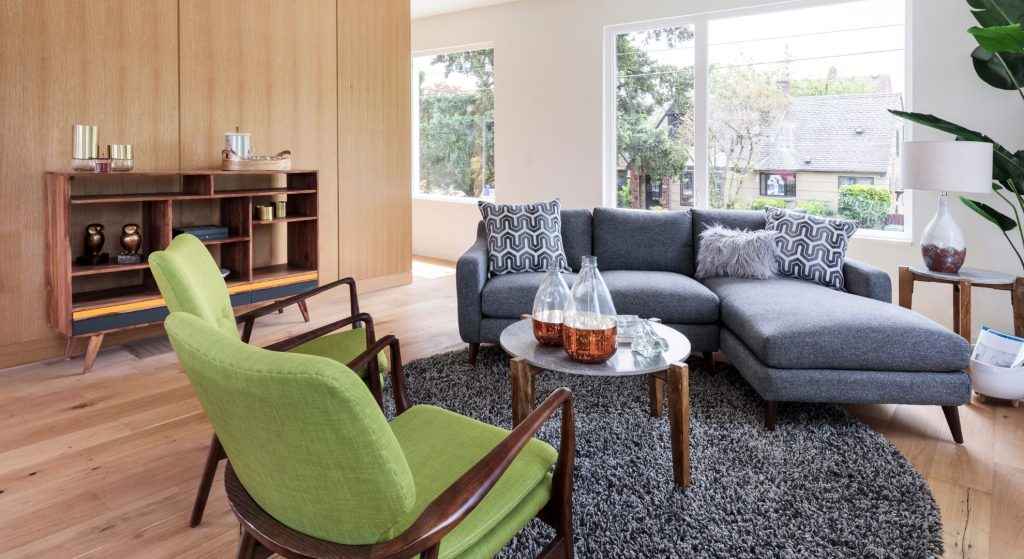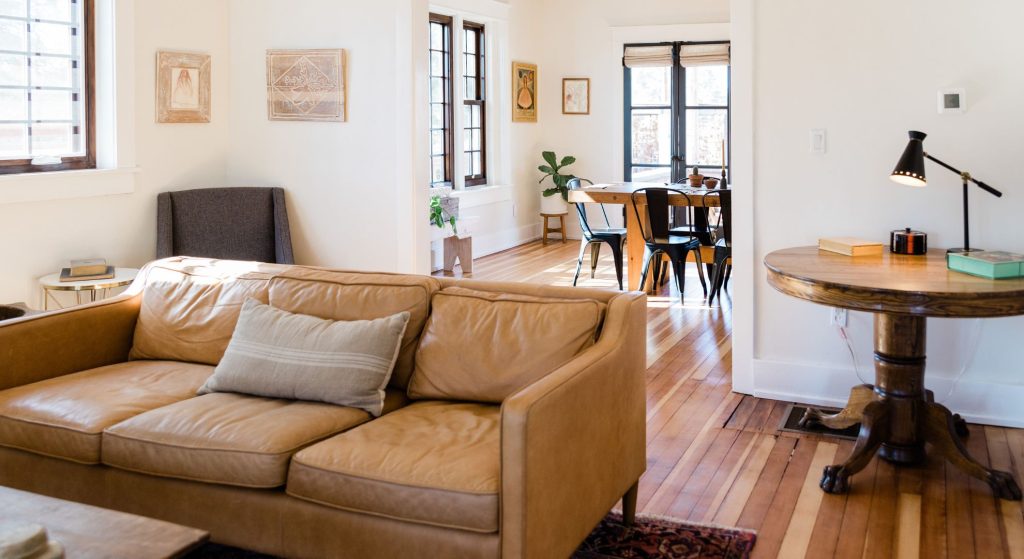Uniting Mid-Century Modern with Minimalism and Modernism
The fusion of Mid-Century Modern, Minimalism, and Modernism in interior design epitomizes the quest for simplicity, functionality, and timeless aesthetics.
Each style brings unique elements, from Mid-Century Modern’s clean lines and organic forms to Minimalism’s serene, clutter-free environments and Modernism’s innovative use of materials and technologies.
This blog post discusses integrating these influential styles to create captivating and practical interiors.
The Foundations of Style

Mid-century modern interior design is celebrated for integrating with nature and emphasizing simplicity and functionality, flourishing from the mid-1940s through the late 1960s.
This style’s charm lies in its sleek lines and organic shapes, designed to bring the outdoors in and create a harmonious living space.
Minimalism strips decor down to essential forms and muted palettes as a design philosophy, increasing the peace and emptiness of excess environments. This movement highlights the beauty of space and structure without overwhelming details.
Modernism in interior design breaks traditional boundaries by embracing new materials and streamlined forms. It’s characterized by a clear rejection of ornamentation, spotlighting efficiency and functionality that reflects the modern age’s spirit.
Marrying the Styles: A Seamless Integration
To link these styles together into a coherent interior design theme, consider these principles:
Furniture Selection
Opt for pieces that display the sleek, functional aesthetics typical of mid century interior design. Choose items like a classic Mid-Century armchair or a minimalist, sculptural coffee table that are not only striking but practical.
Color and Contrast
Maintain a neutral color base of whites, beiges, grays, and blacks to establish a calm, unified backdrop. Introduce vibrant splashes of color carefully, perhaps through a standout piece of art or a bold accent chair, adding layers of interest without dominating the minimalist ethos.
Natural Elements
Use materials like wood, leather, wool, and stone to infuse warmth into the space, a nod to Mid-Century Modern’s love for organic elements. These materials enhance the tactile and visual warmth, balancing the cooler feel of minimalist and modernist spaces.
Functionality and Clutter-Free Living
Each item should serve a purpose, reflecting the minimalist mantra of “less is more.” Design with integrated storage solutions that maintain sleek lines and minimize clutter, essential in mid-century modern home interior design.
Lighting and Openness
Large windows that allow natural light to fill the space are fundamental in all three styles. Complement this with iconic mid century modern interior design style or minimalist lighting fixtures that serve as functional yet decorative elements.
Artistic Flair
Select your accessories and art with intention. Choose pieces that enhance the room’s aesthetic without overwhelming it, ensuring each item harmonizes with the overall design theme.
Color Schemes for a Modern Palette
Choosing the right color palette is crucial in marrying the aesthetics of Mid-Century, Minimalism, and Modernism. Focus on a neutral base to complement the minimalist aesthetic while honoring Mid-Century and Modernist hues.
Shades of white, beige, gray, and black create a clean, uninterrupted canvas that allows architectural details and key pieces of furniture to stand out. Accentuate this neutral palette with bold colors typical of Mid-Century Modern design, such as mustard yellow, teal, or burnt orange, to inject personality and warmth into the space.
For a modern twist, incorporate cooler tones like blues and greens, which enhance the peaceful and open feel vital to minimalist spaces. This approach ensures a balanced, cohesive look that respects the roots of each style while creating a fresh, contemporary environment.
Space Planning for Modern Living

Effective space planning is crucial for integrating the best elements of Mid-Century, Minimalism, and Modernism into a functional and visually harmonious interior. Here’s how to strategically plan your space to enhance both aesthetics and utility:
Define Functional Areas
Clearly outline areas for different activities, such as relaxing, working, dining, or mid-century modern home interior design. Use furniture arrangements or refined room dividers like open shelving units to create these distinct zones while keeping the flow open and airy.
Purposeful Furniture Placement
Choose furniture that serves a specific purpose and complements the overall design theme. Arrange pieces to maintain clear, navigable pathways, avoiding clutter to uphold the minimalist ethos.
Opt for multi-functional furniture that can adapt to different uses, maximizing the utility of every item in the room.
Optimize Natural Light
Position seating and work areas to take advantage of natural light sources, enhancing the mood and functionality of the space.
Use sheer, light-colored window treatments to allow light to fill the space while providing privacy. Consider the placement of mirrors to reflect natural light and visually expand the space.
Material and Color Coordination
Incorporate natural materials like wood, leather, and stone, staples in Mid-Century and Modernist designs, to add warmth and texture.
Stick to a cohesive color palette that compliments these materials, featuring neutral backgrounds with bold color accents for depth and interest.
Consider Traffic Flow
Arrange furniture to facilitate easy movement within the space. To ensure a functional layout that encourages smooth transitions between zones, keep high-traffic areas clear of obstructions.
Blending Styles by Adding Industrial and Scandinavian Touches to Mid-Century Modern Design
Incorporating Industrial and Scandinavian mid century modern interior design elements can enrich Mid-Century Modern interior design. Here are some simple tips for blending these styles to enhance the unique characteristics of Mid-Century Modern décor:
- Industrial Style Interior Design: Add a touch of Industrial style with raw materials like exposed metal and useful furniture, complementing Mid-Century Modern’s clean lines and functional approach.
- Scandinavian Interaction: Merge Scandinavian warmth and minimalism by incorporating light wood, soft textiles, and neutral colors to keep the space airy and inviting.
Creating Harmony in Spaces
Whether you’re redecorating a living room, bedroom, or office, the objective is to craft a timeless and innovative space.
Mid-Century, Minimalism, and Modernism pay homage to design history and adapt to contemporary life, promoting a lifestyle that values comfort, clarity, and beauty.
Through this fusion, we achieve visually stunning interiors that are functionally sophisticated and deeply resonant with our modern way of living.
By merging these styles, we create beautiful spaces and embrace a way of life that celebrates Minimalism, innovation, and the timeless appeal of Mid-Century Modern design. visually stunning but also deeply resonant and reflective of our modern lives.
